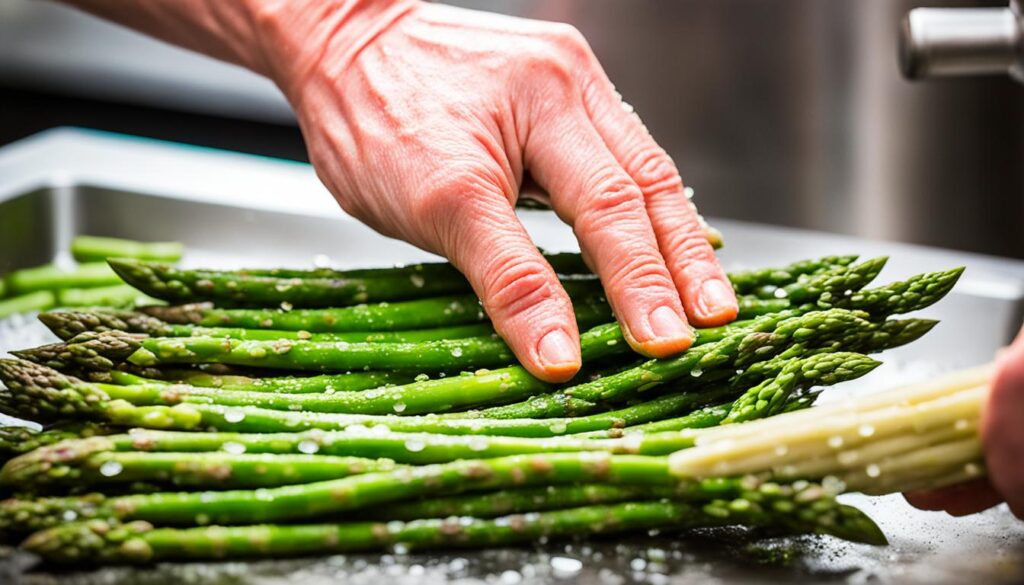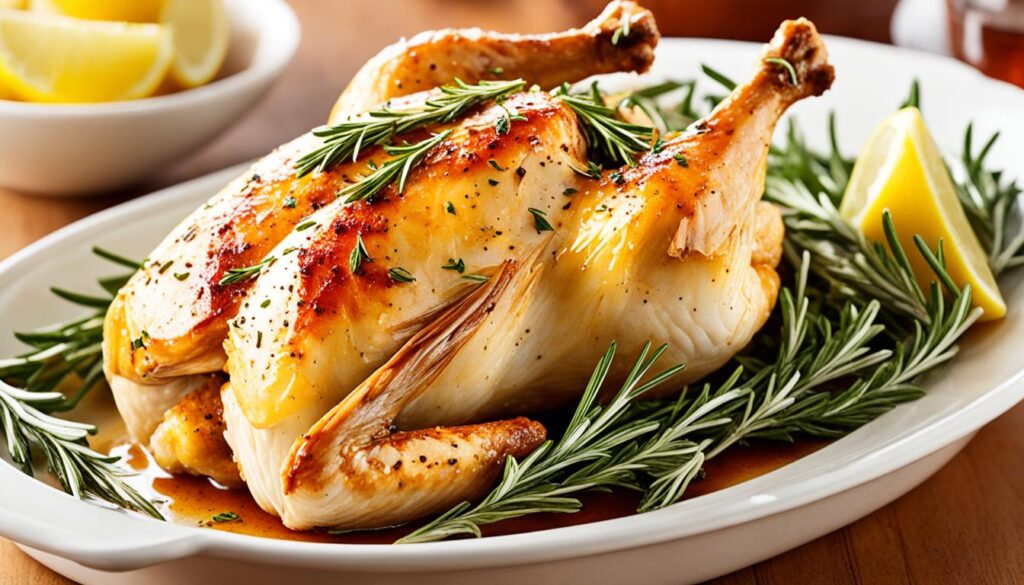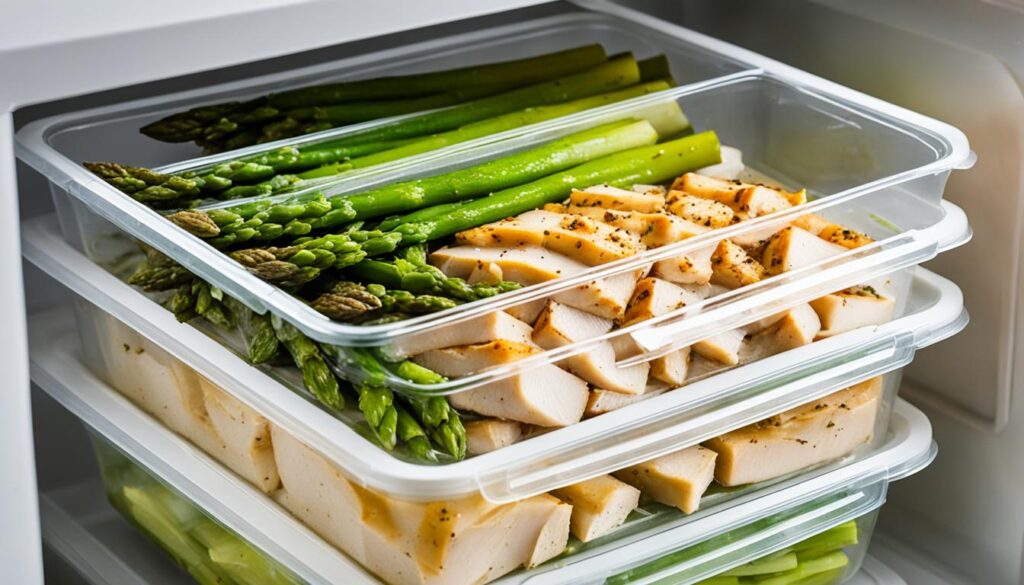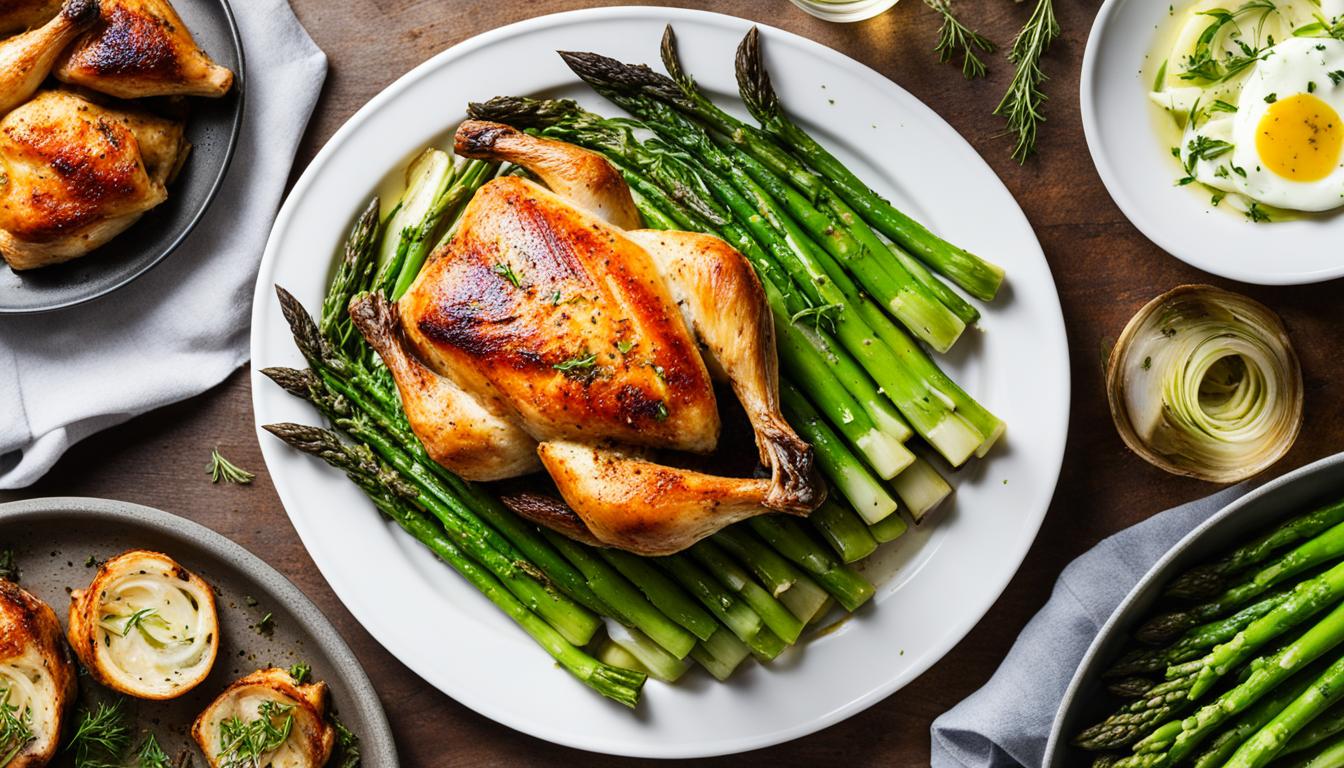Looking for a delicious and hassle-free dinner recipe? We’ve got you covered. Our easy roast chicken with asparagus and leeks recipe is the perfect way to enjoy a flavorful and satisfying meal. But here’s the twist – we’ll show you a technique that will change the way you think about roasting chicken.
What if we told you that you can achieve perfectly roasted breast and leg meat every time without any complicated steps? And what if we also told you that this recipe allows you to use every part of the chicken, ensuring nothing goes to waste? Intrigued? We thought so.
By spatchcocking the chicken – removing the backbone and flattening it – we create a more even cooking surface, resulting in juicy, tender meat throughout. And while the chicken rests, we’ll cook the asparagus and leeks, infusing them with the delicious flavor of the rendered chicken fat.
So, are you ready to try our easy roast chicken with asparagus and leeks recipe? Let’s get started!
Key Takeaways:
- Our easy roast chicken, asparagus, and leeks recipe is a convenient and complete meal.
- By spatchcocking the chicken, we ensure perfectly cooked breast and leg meat.
- Roasting the asparagus and braising the leeks alongside the chicken infuse them with amazing flavors.
- Spring vegetables like asparagus and leeks are the perfect accompaniment to roast chicken.
- With our tips for crispy skin and moist meat, you’ll achieve a restaurant-quality dish at home.
The Benefits of Spatchcocking Chicken
Spatchcocking or butterflying the chicken is a method that involves removing the backbone and flattening the chicken. It allows for more even cooking and ensures that the breast and leg meat cook at the same time. This technique also helps to achieve crispier skin and juicier meat.
Spatchcocking chicken offers several advantages when it comes to roasting. Firstly, by removing the backbone and flattening the chicken, it cooks more evenly. The breast and leg meat cook at the same time, preventing overcooked or undercooked portions. This method also helps to achieve crispy skin, as the chicken lies flat on the roasting pan, exposing more of its surface to the heat. The result is a perfectly browned and deliciously crispy skin that adds texture and flavor to the dish.
Not only does spatchcocking improve the texture of the chicken, but it also enhances the juiciness of the meat. By flattening the chicken, the heat can penetrate the meat more evenly, resulting in juicier and more flavorful meat. The exposed skin also allows the excess fat to render out during cooking, further enhancing the moisture and flavor of the meat. The combination of even cooking and enhanced juiciness makes spatchcocking an ideal method for roasting a chicken.
“Spatchcocking the chicken ensures even cooking and juicy, flavorful meat with perfectly crispy skin.”
Moreover, spatchcocking is a versatile technique that works well with various seasoning and marinade options. The flattened chicken provides a larger surface area for the seasoning to adhere to, resulting in a more flavorful end result. Whether you prefer a simple salt and pepper seasoning or a more elaborate marinade, spatchcocking allows the flavors to penetrate the meat thoroughly, creating a delicious and well-seasoned roast chicken.
Overall, spatchcocking chicken offers numerous advantages when it comes to roasting. From even cooking and crispy skin to juicy and flavorful meat, this method elevates the taste and texture of the chicken. So why not give spatchcocking a try and enjoy a perfectly roasted chicken with all its wonderful benefits?
Advantages of Spatchcocking Chicken
| Advantages | Description |
|---|---|
| Even cooking | Removes backbone for more uniform heat distribution |
| Crispy skin | Flattening exposes more skin to achieve desirable crispiness |
| Juicier meat | Enhanced heat penetration and fat rendering for moist and flavorful meat |
| Seasoning versatility | Flattening provides larger surface area for seasoning to adhere to |
Roasting Asparagus and Leeks
In this recipe, we take advantage of the flavorful rendered chicken fat to roast the asparagus alongside the chicken. This method infuses the asparagus spears with a delicious roasted flavor that perfectly complements their natural sweetness. The leeks, on the other hand, are braised in a quick chicken jus made from the neck and backbone of the chicken. This not only adds a rich depth of flavor to the leeks but also ensures they become tender and melt-in-your-mouth.
Roasting asparagus and braising leeks creates a side dish that is both visually appealing and bursting with flavor. The roasted asparagus takes on a beautiful golden color, while the braised leeks become soft and silky. Together, they make the perfect accompaniment to any meal, adding a touch of elegance and sophistication.
Infusing Flavor with Roasted Asparagus
The asparagus spears are carefully arranged around the chicken in the roasting pan, allowing them to absorb the aromatic flavors of the chicken fat as it renders during cooking. This creates a truly delectable side dish that highlights the natural sweetness and tender texture of the roasted asparagus.
The Tender Sweetness of Braised Leeks
The leeks are first sautéed in the skillet to develop their natural sweetness and enhance their flavors. Then, a quick chicken jus is prepared using the neck and backbone of the chicken. The leeks are then braised in this flavorful liquid, resulting in tender, melt-in-your-mouth leeks that perfectly complement the roasted asparagus.
| Ingredients for Roasted Asparagus and Braised Leeks |
|---|
| 1 bunch asparagus |
| 2 leeks |
| Chicken neck and backbone |
| Chicken fat (rendered from the roasting chicken) |
| Salt and pepper to taste |
Now, let’s take a closer look at how to roast the asparagus and braise the leeks in the full recipe.
Stay tuned to learn more about different methods of cooking spring vegetables and how to achieve crispy skin and moist meat in the upcoming sections.
The Perfect Spring Vegetables
When it comes to spring, there’s nothing quite like the fresh and vibrant flavors of seasonal produce. Spring vegetables, such as asparagus and leeks, offer a delightful combination of delicate flavors and tender textures. These vegetables are a true delight for the taste buds and can elevate any dish they accompany.
One of the best ways to enjoy spring vegetables is by cooking them in a way that brings out their natural sweetness and preserves their crispness. The minimal cooking required allows the vegetables to retain their vibrant colors and nutritional value.
Asparagus and leeks are particularly suited to be paired with a roast chicken dinner. While the chicken rests after roasting, these spring vegetables can be quickly cooked to perfection. This convenient preparation method ensures that your entire meal comes together effortlessly and in a timely manner.
Asparagus, with its bright green color and tender stalks, lends a fresh and crisp element to the plate. Leeks, on the other hand, offer a mild onion-like flavor and delicate texture. The combination of these two spring vegetables not only adds a burst of flavor but also complements the succulent roast chicken perfectly.
So, when planning your next springtime feast, don’t forget to incorporate these seasonal gems. Your taste buds will thank you!
Benefits of Cooking Spring Vegetables
There are several advantages to cooking spring vegetables:
- Minimal cooking time allows vegetables to retain their natural sweetness and crispness.
- Preserves the vibrant colors and nutritional value of the vegetables.
- Complements and elevates the flavors of other dishes.
- Provides essential vitamins, minerals, and fiber for a healthy diet.
- Allows for a variety of cooking methods, including roasting, sautéing, and grilling.
Whether you’re an experienced home cook or just starting out, experimenting with spring vegetables can open up a world of culinary possibilities. From light and refreshing salads to hearty and comforting mains, the versatility of these vegetables knows no bounds.
The Easy Roast Chicken Method
Roasting a chicken to perfection doesn’t have to be complicated. Our easy roast chicken method ensures a flavorful and juicy result every time. Here’s how to do it:
Ingredients:
- 1 whole chicken
- Salt and pepper
- Optional: Herbs and spices for seasoning
Instructions:
- Preheat your oven to 500°F (260°C).
- Place the chicken on a roasting rack in a roasting pan.
- Season the chicken generously with salt and pepper. You can also add your favorite herbs and spices for extra flavor.
- Roast the chicken in the preheated oven for about 15 minutes per pound. For example, a 4-pound chicken should be roasted for about 1 hour.
- Check the internal temperature of the chicken using an instant-read thermometer. The thickest part of the breast should register 150°F (66°C).
- Once the chicken reaches the desired temperature, remove it from the oven and let it rest for 15 minutes before carving.
Follow these steps, and you’ll have a perfectly roasted chicken with crispy skin and tender meat. The high roasting temperature ensures a golden brown crust, while allowing the chicken to rest ensures that the juices redistribute, resulting in moist and flavorful meat.
| Roast Chicken Cooking Time | Roasting Temperature for Chicken |
|---|---|
| Approximately 15 minutes per pound | 500°F (260°C) |
Remember, cooking times may vary depending on the size of the chicken. It’s always a good idea to use an instant-read thermometer to ensure the chicken is cooked to the proper temperature.
Making the Chicken Jus
Now that we have roasted the chicken and prepared the asparagus and leeks, it’s time to make the flavorful chicken jus. This homemade chicken jus will add depth and richness to the dish, enhancing the overall flavor profile.
To make the chicken jus, we start by chopping up the neck and backbone of the chicken. This not only helps to extract the maximum flavor but also ensures that every part of the chicken is utilized. We recommend using a sharp knife and cutting the pieces into smaller chunks for better extraction of flavors.
In a saucepan, we brown the chopped neck and backbone. This step helps to develop a rich and robust flavor. Make sure to scrape up any browned bits from the bottom of the pan, as they add depth to the jus.
Next, we add the leek greens and bay leaves to the saucepan. These ingredients contribute their own unique flavors and aromas to the chicken jus. Leek greens add a subtle onion-like taste, while bay leaves provide an earthy and slightly floral note.
The mixture is then simmered over low heat to extract the flavors from the ingredients. This process allows the jus to develop its characteristic savory taste. We recommend simmering for about 30 minutes, but you can adjust the time according to your taste preferences.
Once the simmering is done, it’s time to strain the chicken jus. Using a fine-mesh strainer or cheesecloth, strain the jus into a separate container, discarding any solids. This step ensures a smooth and velvety texture, free from any unwanted bits.
Finally, the chicken jus is ready to be used. In our recipe, we use it to braise the leeks, infusing them with the rich flavors of the chicken. The result is a side dish that perfectly complements the roast chicken and asparagus.
“The homemade chicken jus adds a depth of flavor that elevates the entire dish. It’s a simple yet essential step that takes the roast chicken with asparagus and leeks to another level of deliciousness.”
Preparing the Asparagus
Asparagus is a versatile and delicious vegetable that pairs perfectly with roast chicken. To ensure that your asparagus cooks evenly and has a tender texture, it’s important to follow a few simple steps in its preparation.
- Trimming asparagus: Start by trimming the tough ends of the asparagus stalks. These ends can be woody and fibrous, so it’s best to remove them to enhance the flavor and texture of the asparagus. Simply hold each stalk near the bottom and bend it gently until it snaps. The end that breaks off is the tough part that should be discarded.
- Peeling asparagus: Depending on the thickness of the asparagus stalks, you may also need to peel them. Thicker stalks can have a tougher outer layer that benefits from peeling. Using a vegetable peeler, gently peel the bottom half or two-thirds of the stalk to remove the outer skin. This step helps to soften the asparagus and ensures a more enjoyable eating experience.
Once you’ve trimmed and peeled your asparagus, it’s ready to be roasted alongside your chicken. The asparagus will absorb the delicious flavors of the roasted chicken and become a flavorful and satisfying side dish. Enjoy the tender and tasty asparagus alongside your perfectly roasted chicken for a complete and delightful meal.

Serving the Roast Chicken
Once the roast chicken has been allowed to rest and absorb its juices, it’s time to serve this delectable dish. Follow these steps to ensure a visually appealing and flavorful presentation:
- Carve the Chicken: Using a sharp knife, carefully carve the chicken into serving pieces. Start by removing the legs, followed by the wings, and then separate the breast from the bone. Ensure each piece has a balance of tender breast and succulent leg meat.
- Transfer the Braised Leeks: Using a slotted spoon, transfer the braised leeks from the pan to a serving platter. Leave the flavorful jus in the pan for now. The golden-brown leeks add a touch of sweetness and a hint of richness to the dish.
- Arrange the Asparagus and Carved Chicken: Place the roasted asparagus alongside the braised leeks on the serving platter. The vibrant green color of the asparagus complements the golden-brown chicken and adds freshness to the dish. Arrange the carved chicken pieces on top of the vegetables.
- Pour the Jus: Pour the reserved chicken jus around the asparagus and carved chicken on the serving platter. The jus imparts additional depth of flavor to the dish and enhances every bite.
- Garnish with Fresh Herbs: Finish the presentation by garnishing the dish with fresh herbs, such as tarragon or parsley. The vibrant green herbs provide a pop of color and a refreshing aroma, elevating the overall presentation.
This beautifully plated roast chicken with tender asparagus, braised leeks, and a rich chicken jus is now ready to be enjoyed. Serve it family-style at the dinner table, allowing everyone to indulge in the irresistible flavors and textures.
| Ingredients | Equipment |
|---|---|
|
|
Now, imagine the stunning sight of the perfectly carved roasted chicken arranged alongside vibrant asparagus and flavorful leeks, all drizzled with a luscious chicken jus. It’s a feast for the eyes and the taste buds. Get ready to savor every mouthwatering bite!
Tips for Crispy Skin and Moist Meat
To achieve crispy chicken skin on the roast chicken, follow these tips:
- Pat the chicken dry before seasoning it with salt and pepper. This helps to remove excess moisture from the skin, allowing it to crisp up during roasting.
- Roast the chicken at a high temperature, such as 425°F (220°C) or higher. The intense heat helps to render the fat under the skin, which contributes to a crispy texture.
- Make sure the chicken is properly rested after roasting. This allows the juices to redistribute throughout the meat, resulting in a moist chicken meat that is not dried out.
By following these tips, you can achieve the perfect balance of crispy chicken skin and moist chicken meat in your roast chicken.
“The key to achieving crispy chicken skin is to begin with a dry surface. This can be achieved by patting the chicken dry with paper towels before seasoning it.” – Chef Julia Smith
Allowing the chicken to rest after roasting is an essential step to retain moisture. During the resting period, the residual heat gently finishes cooking the chicken while the juices are reabsorbed, resulting in a tender and juicy meat.
Here is an example of a simple table highlighting the contrast between crispy chicken skin and moist chicken meat:
| Crunchy Crispy Chicken Skin | Tender and Moist Chicken Meat |
|---|---|
| Golden brown color | Juicy, succulent texture |
| Irresistibly crispy texture | Full of flavor |
| Satisfying crunch with every bite | Melts in your mouth |
Remember, achieving crispy chicken skin and moist chicken meat is a delicate balance. It requires proper preparation and cooking techniques to ensure a delicious and satisfying roast chicken experience.

Vegan Adaptation of the Recipe
If you’re following a vegan diet, you can still enjoy the delicious flavors of a roast chicken dinner by making a simple adaptation to the recipe. Instead of using chicken, we can substitute tofu as a flavorful and protein-rich alternative. Here’s how:
- Season and marinate the tofu: Just like the chicken, we can season the tofu with salt, pepper, and any other desired seasonings. To enhance the flavor, we can also marinate the tofu in a marinade of our choice, allowing it to absorb the flavors before roasting.
- Roast the tofu and vegetables: Place the seasoned and marinated tofu on the same sheet pan as the vegetables. This allows for convenient cooking and ensures that both the tofu and the vegetables cook together, infusing each other with delicious flavors.
- Follow the same cooking instructions: Roast the tofu and vegetables at the recommended temperature and for the same amount of time as the roast chicken recipe. This will ensure that the tofu is perfectly cooked and the vegetables are tender and flavorful.
By following these simple steps, you can create a satisfying and flavorful vegan sheet pan dinner that captures the essence of the original recipe. The tofu acts as a versatile substitute for the chicken, providing a deliciously wholesome and protein-packed alternative for vegans.
| Ingredient | Quantity |
|---|---|
| Tofu | 1 block |
| Salt | To taste |
| Pepper | To taste |
| Additional seasonings | To taste |
Leftovers and Storage
When it comes to the delicious roast chicken with asparagus and leeks recipe, there’s a good chance you’ll have some leftovers. But don’t worry, storing and reheating them is a breeze!
After enjoying your meal, simply store any remaining leftovers in an airtight container and place it in the fridge. Proper storage will help maintain the flavor and freshness of the roast chicken.
Leftover roast chicken can be reheated in a variety of ways:
- Microwave: Place the desired portion of the chicken on a microwave-safe plate and cover it with a microwave-safe lid or microwave-safe plastic wrap. Heat it on high for 1-2 minutes or until it reaches your desired temperature. Be sure to check for any hot spots before consuming.
- Stovetop: For a more hands-on approach, you can reheat the chicken on the stovetop. Simply heat a skillet over medium heat and add a little bit of oil or butter. Once the skillet is hot, place the chicken in the pan and cook it until it’s heated through, stirring occasionally to ensure even heating.
- Oven: If you prefer a crisper texture, reheating the roast chicken in the oven is a great option. Preheat your oven to 350°F (175°C). Place the chicken on a baking sheet or in an oven-safe dish and cover it with foil. Bake for about 15 minutes or until the chicken is heated through.
Now that you know how to reheat the leftover roast chicken, let’s explore some creative recipe ideas to make the most of your leftovers:
- Chicken and Vegetable Stir-Fry: Sauté the leftover roast chicken with your favorite stir-fry vegetables and season with soy sauce, ginger, and garlic for a quick and flavorful meal.
- Chicken Salad: Chop the leftover roast chicken into bite-sized pieces and toss it with mixed greens, cherry tomatoes, cucumbers, and your favorite salad dressing for a refreshing lunch or dinner.
- Chicken Wrap or Sandwich: Layer the leftover roast chicken on a soft tortilla or sandwich bread along with your favorite toppings, such as lettuce, tomatoes, and avocado, for a satisfying and portable meal.
Get creative and experiment with different flavor combinations to transform your leftover roast chicken into delicious new dishes. Don’t let anything go to waste!

Conclusion
In conclusion, the easy roast chicken with asparagus and leeks recipe is a simple and delicious meal that perfectly captures the flavors of spring. By spatchcocking the chicken and roasting it alongside the vegetables, you can create a flavorful and complete dish that will impress your family and friends.
The spatchcocking method ensures that the chicken cooks evenly, with crispy skin and moist meat. The roasted asparagus and braised leeks complement the chicken beautifully, absorbing its flavorful juices. The result is a satisfying and wholesome meal that celebrates seasonal produce.
Whether you choose to make this recipe with chicken or tofu as a vegan alternative, the flavors and textures will not disappoint. It is a versatile dish that can be enjoyed for a weekday dinner or served as a special occasion centerpiece.
So, gather your ingredients and give this easy roast chicken with asparagus and leeks recipe a try. You’ll be rewarded with a mouthwatering meal that is sure to become a family favorite. Enjoy!
